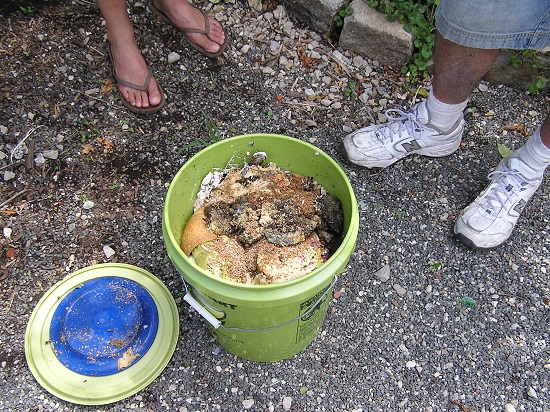
When you do not have space to compost or the time to do it, The Bokashi Method may be the solution for you. Bokashi is a Japanese word meaning “organic matter”. The “organic” component can be any dried plant material. It is a pickling process and can be an alternative to composting that is faster, easier, and without foul odor.
The Bokashi Method for recycling food wastes involves collecting food wastes, adding them to an airtight container, inoculating the wastes with a fermented inoculant called Bokashi, and letting the materials pickle in an airtight container for 2-4 weeks. Once the materials are fully pickled, they are simply buried in the ground, added to a worm bin or to an existing compost pile where they will break down in 2-4 weeks. There is no turning involved in this process!
You can make your own Bokashi or buy some ready-to-use from a variety of sources. Bokashi that is used for food waste recycling is usually made with either rice bran or wheat bran. Wheat bran is about half the cost of rice bran. Rice bran, however, contains more nutrients, making it more beneficial to soils and plants. If you are on a tight budget, you can make Bokashi with any dried plant material including dried leaves, dried grass, and even sawdust.
To pickle food wastes, start off by adding a light coating of Bokashi on the bottom of the bucket. Continue adding food wastes, coating with Bokashi, until the bucket is full. It usually takes a little over 1 pound of Bokashi per 5-gallon bucket. You cannot use too much, but you can use too little. Be sure to put the lid on tightly when not in use. If there is a lot of liquid produced in the bucket, add something to soak it up: bread, paper (nothing with colored inks), or more Bokashi.
It usually takes an average family of 4 about one week to fill one bucket. Let the materials pickle for at least one more week before disposing of the contents in the ground. Start another bucket while the first one pickles for another week. The materials do not break down in the bucket! Do not expect the materials to look like soil when pickled. Instead, expect the pickled foods to look very much like they did when you started.
What Happens in the Bucket?
The food wastes supply nutrients that feed the microbes in the Bokashi. As the food wastes pickle, the microbes produce a variety of beneficial substances. Some of these substances include enzymes, vitamins, amino acids, trace minerals, some plant hormones, and organic acids. The pickling process controls pathogens and damages seeds in the container. Worms, insects, and other beneficial microbes finish the process of digestion after the contents are added to the soil. The result over a couple of weeks is increased microbe populations and bio-available nutrients supplied to plants growing in the area.
Because the process takes place in a closed container, there are no odor or fly problems. All food wastes can go into these buckets, including meats and dairy products, cooked and raw. Just be sure not to add too much liquid, keep the container airtight when it is not being filled, and to use enough inoculant (Bokashi) to ensure the materials are fully pickled.
Assuming it took 1 week to fill the bucket and another week to ferment (about 2 weeks), the contents of the bucket are pickled. First check to see that they do not smell bad. There should be a sweet to sour smell, but nothing foul. Here are some options on what to do with the contents of the bucket:
- Bury the contents of the bucket in a hole or trench about 8-12 inches deep. Use the soil that was removed to cover the pickled food waste. Plant seeds in the soil immediately after filling the hole. If you are planting transplants, wait 1-2 weeks before planting. Pickled food wastes can also be added around established plants throughout the year without causing any damage to the plants.
- Add it to and existing compost pile. Just dig in the pile, empty the bucket, and cover pickled food waste with compost materials.
- Feed it to worms in a worm bin.
Troubleshooting
If the bucket has a foul odor, two things may have happened. Either the bucket was not kept closed tightly or there was not enough Bokashi used. You can fix this by adding more Bokashi and about ¼ cup table sugar. Mix the contents, close the bucket, and let it pickle for a few days. Check it and see if it smells better.
If there is green or black mold in the bucket, you did not add enough Bokashi and/or did not close the bucket tightly. Bury this material, adding in another pound of Bokashi, cover and let it break down in the ground for about 4 weeks before planting.
Try it out. Who knows, you may find that you ditch the compost pile for a 5-gallon bucket.
Eric Lancaster is Executive Vice President of TeraGanix, Inc. He has been using the Bokashi Method at home and commercially for 14 years. You can visit their website at Teraganix.com.



Comment here